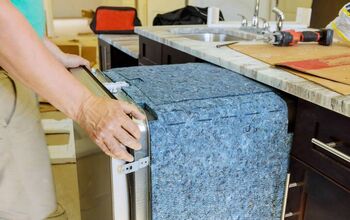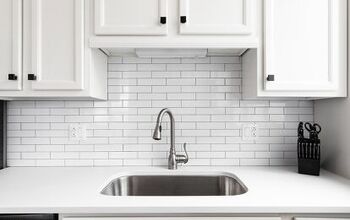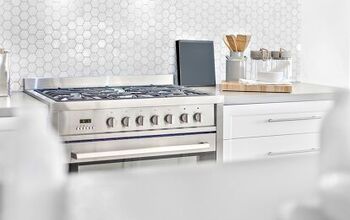Granite Countertop Not Flush With Wall? (We Have a Few Fixes)

Granite countertops are amazing for both kitchens and bathrooms. They look elegant and are famous for creating a beautifully seamless look to your home. Sadly, not all countertops end up looking the way they were supposed to. If you ended up doing a renovation, you might be disappointed to see that your granite countertop isn’t flush with your wall. It’s bad. But, what can you do?!
A granite countertop that isn’t fully flush with your wall is due to poor manufacturing, mismeasurements, or a bad install. This leaves only a handful of options for people who want to fix it:
- Use Caulk To Seal The Gap
- Add A Backsplash
- Add Trim To Your Gap
Clearly, there’s a good chance that you want to park your sneaker up the rear end of the contractor or designer that made this happen. Unfortunately, you can’t legally do that. That’s why this article will be about learning how to reduce the appearance of that gap.
Don't want to do it yourself?
Get free, zero-commitment quotes from pro contractors near you.

Why Isn’t Your Granite Countertop Flush With Your Wall?
This is a great question, and it isn’t always obvious. The most common reason why is because someone made the wrong measurements, which in turn, means that your counter just ended up being short. However, it also can be because of a mistake during installation—something along the lines of placing the counter and cabinetry too far from the wall. Or sometimes, the wall just isn’t straight!
A rarer issue that could happen is that the manufacturer of your granite slab could have cut the counter too small. If you measure your countertop and find it to be the incorrect size, call the provider of the counter immediately and explain the situation. They may be able to help you out or at least give you a partial refund.
Can You Get Your Countertop Replaced?
It’s highly unlikely (and not even advisable) to think that you are going to be able to convince a granite manufacturer to replace your countertop. While it’s always a good idea to ask and even post a complaint about their service online, there’s something to be said about the fact that most manufacturers (or installers) tend to have their hands tied on the matter.
Important Note: If your countertop has not been bolted in quite yet, it may be possible to float the wall using extra sheetrock or wood paneling so that the wall meets the counter. However, we’re going to write this under the assumption that you already installed the countertop and don’t have this option available to you.
Fixing That Granite Countertop Gap
Now that we’ve gone over the “why’s,” it’s time to figure out how to fix the entire issue. It’s clear you’re stuck with a gap in your countertop. Here’s how you can make the gap go away…
Using Caulk
If you have a tiny gap, then the easiest and fastest way to make your counter go flush with your walls is to use waterproof sealing caulk. This is a good choice, since you can choose both transparent caulk or a caulk that matches your particular granite. It’s smooth, and effortless to do.
This method is good for gaps that are under 1/2 inch in width. If you have a counter gap that’s a little larger, you might be able to continue to use this method if you add a backing rod to help keep the caulk together. To use this method, add a small layer of caulk across the gap in one long line. Let it dry, and you should be good to go.
Add A Backsplash
Most kitchen and bathroom counters will have a backsplash already, so if you do, don’t bother with this. On the other hand, if you don’t have a backsplash on your wall, then you can add a thick backsplash on the wall to cover the gap. This is best done with a long slab of granite that is of a similar shade to the granite on your counters.
Gluing, caulking, or otherwise affixing the backsplash to the wall is a good move here. If you aren’t good with backsplash installation, then you probably should call an installation company to assist you.
Adding Trim To Your Wall
Let’s say that you called installers, and they really fudged up. There is now a gap that’s so large, you can fit your thumb in there. To make matters worse, it’s also difficult to find a way to keep things near it. If this is the case, you will need to install molding or trim to bridge the gap. Should you choose to do this, there are a couple of hints you need to know:
- Plan out your corners early. The best way to handle corners with molding is to cut each end at a 45-degree angle and join them together in a corner.
- Use the molding or trim mounting method that your trim material requires. There’s a difference between trim made out of plastic and trim made of granite. Each will have its own steps and procedure, so make sure you read up on how to install the trim you buy before you do it.
- Choose a trim that doesn’t clash with your counter. Granite countertops work well with brushed metal, darker shades of plastic, as well as a wide range of different wood trims. If you are not sure whether or not a trim works well with your particular shade of granite, ask an interior designer for some help.
- If the reason why your granite isn’t flush with the wall deals with badly cut counters, the best thing you can do is buy trim elsewhere. Why give an establishment two different ways to mess up your home?
Can You Just Leave The Gap Alone?
You can, but it’s not a good idea. The gap that’s between your counter and the wall can cause a slew of problems that could turn into a kitchen nightmare—and not the Gordon Ramsay type! Here’s why you shouldn’t leave the gap to stay there without some kind of coverage:
- First off, it doesn’t look good. A granite counter is elegant. A granite counter that isn’t flush with the wall is going to look sloppy AF. Don’t be the person who leaves a pretty counter looking unfinished.
- Things can fall into the gap. This can turn your kitchen into a sanitation issue. For example, if you end up spilling soup, there’s a good chance it’ll leak down behind the counter. You can’t clean that part of your wall easily, since the gap is probably under an inch wide. This means your soup will sit there and fester. And get moldy. And eventually, it can do permanent damage to your walls.
- It can also be a safety hazard. We’ve all had our clothing catch onto a sharp corner. Sometimes, those snags can hurt. This can happen with a gap between your wall, too.
- Oh, and let’s not even begin with what it could mean for certain pests. Mice do not need a lot of space to be able to get into an area. The same can also be said for roaches and ants. All these pests can pose a serious risk for your food sanitation as well as your ability to store food.
- A very noticeable gap can also reduce property values. If a property inspector sees it, he will probably make a note about how much it’ll take to fix it. This can make it a smidge harder to sell a home.
Do You Need Stone and Granite Countertop Repair?
Get free, zero-commitment quotes from pro contractors near you.

Related Questions
Are four-inch backsplashes outdated?
Four-inch backsplashes were all the rage during the early 00s to early 2010s, but this trend has since fallen by the wayside…and hard! Though they were once the hallmark of a modern kitchen, four-inch backsplashes are now considered to be heavily dated. If you want to go for something more modern (and easier to clean), opt for a full tile backsplash setup.
When does it make sense to install a four-inch backsplash?
A four-inch backsplash might be a bit outdated, but there are still some moments where having one can make a lot of sense. If you want to have a granite backsplash and can’t handle the high price tag of a full backsplash, then you should consider getting a four-inch backsplash instead.The smaller size makes the act of getting real granite a lot more affordable, all while keeping a seamless look to your counter. While it’s not ideal, it still works pretty well and acts as a more forgivable twist on a dated look.
What is the best material for countertops?
If you want to get a countertop that adds value to your home, then you should opt for natural stone countertops or engineered stone countertops. These two terms cover a wide range of materials that are based in stone, including top picks like granite, marble, quartzite, and quartz.Stone and engineered stone counters are considered to be the most durable, not to mention the safest. Since they are also fairly pricey, many also believe them to be status symbols in their own rights.

Ossiana Tepfenhart is an expert writer, focusing on interior design and general home tips. Writing is her life, and it's what she does best. Her interests include art and real estate investments.
More by Ossiana Tepfenhart




















![10 Most Dangerous Neighborhoods in Baltimore [Updated]](https://cdn-fastly.upgradedhome.com/media/2023/07/31/9075655/10-most-dangerous-neighborhoods-in-baltimore-updated.jpg?size=350x220)






